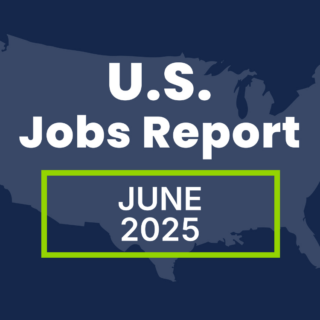In the recruitment space, skills-based hiring is on the tip of talent acquisition leaders’ tongues. Is it worthy of all the ink spilled or just the flavour of the month?
The internet is buzzing with headlines framing skills-based hiring as a revolutionary step forward—a clean break from “outdated” methods like focusing on academic qualifications. But as usual, we want to take a more critical look.
Let’s step away from the hype to examine the real pros and cons of skills-based hiring. More importantly, let’s figure out how skills-based hiring can work for you.
Skills-Based Hiring: Is it Really New?
There are three common myths being perpetuated by many of the articles about skills-based hiring:
Myth 1: Educational qualifications have been the main barrier to good hiring decisions.
The argument goes that recruiting teams rely too heavily on degrees and don’t think enough about skills—and if they just focused on skills instead, all their hiring issues would be solved.
This misrepresents how most employers actually make hiring decisions. While education requirements do exist in job descriptions, they’re rarely the primary factor in final hiring choices. Most recruiters already consider multiple factors including experience, cultural fit and demonstrated abilities. Skills-based hiring has its positives and certainly feels more inclusive than rigid degree requirements, but it’s not the revolutionary shift from degree-obsessed hiring that many articles suggest.
Myth 2: Everyone talking about skills is talking about the same thing.
One reason the history of skills-based hiring is hard to track is the absence of a clear, consistent definition of what constitutes a “skill.” In the context of skills-based hiring, a skill could be a competency, strength or motivation—anything that enables a person to do the job well. That landscape is far more nuanced and complex than most articles let on.
The reality is that defining skills is a lengthy process and requires careful consideration of context. But most writers on this subject don’t bother to grapple with this complexity. Instead, they gloss over any real explanation of what skills are, feeding the perception that skills are so simple and universally understood that we don’t need definitions. This creates the illusion that organizations should be able to easily incorporate skills-based approaches without doing the hard work of actually defining what they mean by “skills” in their specific context.
Myth 3: Skills-based hiring and talent management is a new idea, and the bandwagon is leaving the station.
Headlines will have you believe that skills-based hiring is “the next big thing” and a silver bullet that will solve all your workforce woes. However, this doesn’t really reflect most hiring processes.
Even if you’re not actively thinking about skills-based hiring, it’s likely that it is embedded—at least partly—into your hiring process already. Today, recruiters rarely just think in terms of hiring somebody because their qualifications line up to the “essential” section of the job description.
So, skills-based hiring isn’t a new idea. The term might be, but not the practice.
These myths lead us to feel that the noise around skills-based hiring is misleading. It suggests that skills-based hiring is driving the recruitment industry right now, when in reality, very few are moving forward with it in an overt, intentional way.
Getting Started with Skills-Based Hiring When Time and Budgets Aren’t Huge
If you do want to embrace skills-based hiring, here are some practical steps:
1. Start with an Audit
If you’re keen to implement skills-based hiring, first of all, feel reassured that it’s likely already part of your approach, even if you don’t call it that. Start by establishing where you are along the skills-based continuum.
Diagnostics come into their own here. Assess your hiring processes in a structured way, identifying gaps, strengths and opportunities for improvement. It can be beneficial to bring in an external partner like the PeopleScout Assessment Design team, to provide robust, evidence-based, unbiased feedback to maximise impact.
2. Defining Your Skills
Then it comes down to defining skills—for now and the future. These can’t be vague; they need to be carefully defined so that they can be accurately applied. You’ll build these from research, both internally and by looking externally. If you want to have an organisation-wide approach, you’ll need to consider skills relevant for leadership and entry level roles and across departments. Engage your department heads and hiring managers to map these.
3. Look at Your Non-Skills Criteria
You don’t have to remove looking at academic qualifications from your hiring process entirely. However, if there are instances where you’re using an academic qualification as a stand-in for a skill—say, a humanities degree as a signifier of good written communication skills—you can probably move away from it and start focusing more explicitly on the skill itself.
Skills-based hiring can open doors for many candidates—and expand your talent pool. Perhaps your ideal candidate did not go to university, but their written communication skills are more than adequate for the role.
4. Kick Off a Pilot
Even without a big budget to fund an overhaul of your recruitment processes, it’s still possible to make a start. To make it manageable, begin with a small, pilot process. Your audit can help you identify the best starting point—perhaps it’s a particular department or role type.
Once you’ve started, you’ll want to closely monitor it to ensure that the benefits are genuine. Try not to feel pressured into investing too much time, money and resources into skills-based hiring because it is a hot topic. Make changes bit by bit, turn to evidence, and stay reflective.
The Bottom Line
Don’t get overcome by buzzwords. In all likelihood, skills-based hiring has been a part of your process for a while now. If you want to concentrate more on skills-based hiring, start small, remain sceptical of the hype, get external insight, be evidence-based and keep evolving your approach.




![[Webinar] Smart Hiring in the AI Age: What UK Candidates Are Really Doing in 2025](https://www.peoplescout.com/wp-content/uploads/2025/05/AI-enable-applicant-report-320x320.jpg)